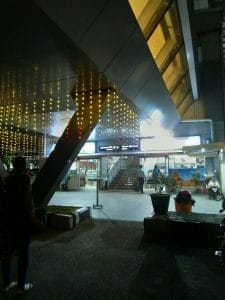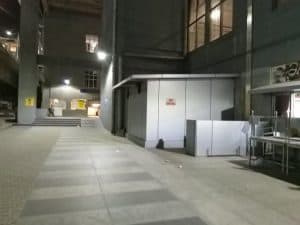India does a poor job of providing signage, and nowhere is it more evident than at the Chennai Airport.
So here are some pointers to finding the Chennai Metro station and Tirusulam suburban train station from the arrivals area. There are no MTC airport buses in operation.
When you are leaving the International Arrivals area, you pass through a small canopy from which you can see the car parking area ahead, and the Chennai Metro station on your left. The difficulty is in locating the elevator that will take you and your baggage to the concourse level of the Metro.

The entrance to the Chennai Airport Metro at the ground level is actually through this eatery. Photos : G. Ananthakrishnan (Creative Commons)
The picture above shows the station entry, flanked by two entrances to a big AAI Canteen, which is open to both Airport Authority staff and the public. Tip: It offers cheaper, more varied food than the kiosks inside and outside the airport.
Go past the canteen entrance to the left, and you will see the car parking area of the Metro ahead (pictures below). Here, you notice a sign pointing to the elevator. Walk in, and the elevator is at the left. Proceed to the concourse, and good luck.

This is the pathway that leads to the rear of the canteen seen in photo above. Credits: G Ananthakrishnan
Finding the Tirusulam station is much more difficult. You must walk beyond the Metro point described above, on to the left, and look for the ticket booths for car entry. Walk past the booths and ahead, until you spot the entrance to the Tirusulam Pedestrian Subway (photo below). This is the entry you want to take, to reach the suburban train station. The Grand Southern Trunk road is on the right.
As with many things Indian, the elevator in the subway does not work. So be prepared to haul your luggage to the station crossing some flights of stairs. There is one ramp leading to the train platform beyond the booking office, though.
Other than at the subway entrance, there are no boards pointing to either the subway or suburban train station. So why take the trouble to walk to the suburban train? It costs five Indian rupees for a distance of about 10 km, while the Chennai Metro costs Rs. 40!
But bear in mind, the Tirusulam station area can be rough, since it is not well illuminated. Exercise caution depending upon the time of your travel. Nights can be tricky, since there is no significant police presence.
Here’s a piece in The Hindu on how quickly you can get to the airport by the different travel choices currently available in Chennai.
[This has been republished with permission from the popular blog Straphangers United; the original post can be viewed here.]

